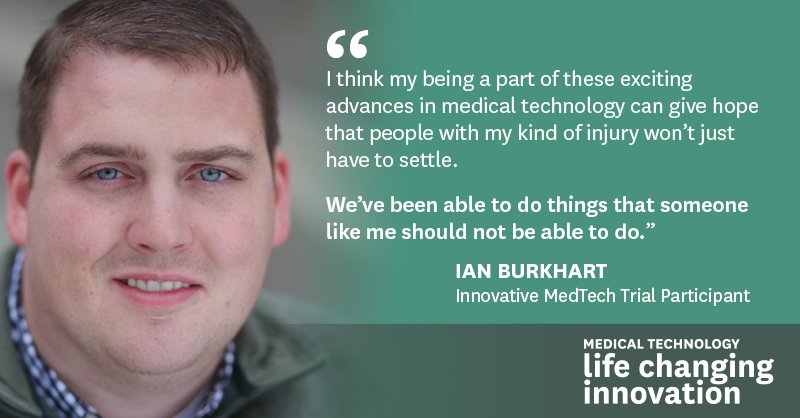Ian Burkart is not only a firm believer in the promise and power of medical technology, he embodies it. If you ask him, though, this certainly did not come about by choice.
THE ACCIDENT
Shortly after his freshman year of college and while on summer vacation with a group of friends, the Dublin, Ohio native made an ill-fated dive into a wave off the shores of the outer banks of North Carolina. That dive changed his life forever. Ian was paralyzed from the shoulders down and had to process the news that he was a quadriplegic.
PUTTING FAITH IN MEDICAL TECHNOLOGY
Ian could have given up and just accepted his lot in life, but he didn’t; he viewed his situation as a challenge to do better than what his doctors had predicted for his future. “One of the things that has helped me mentally ever since the accident is the fact that technology is advancing at such a rapid rate. I always knew there would be a remarkable development that could help me; I just didn’t know what or when that would be,” he said.
Ian became an avid study of advances in science and medicine, asking anyone and everyone he came across if they knew of any research studies addressing the restoration of movement in paralyzed limbs. As it turned out, Ian happened to be in the right place at the right time. He learned that a group of researchers at Ohio State University in Columbus, Ohio – almost literally in Ian’s backyard – had partnered with Battelle to develop a first-of-its-kind reanimation technology experiment.
“I think my being a part of these exciting advances in medical technology can give hope that people with my kind of injury won’t just have to settle. We’ve been able to do things that someone like me should not be able to do.”
REANIMATING IAN’S RIGHT HAND
Ian became a participant in a clinical trial involving a brain machine interface to control his muscle stem. Ian had brain surgery to implant a microchip, which facilitates the “reanimation” of his right hand, wrist and fingers when he is wired to a computer, which in turn is wired to a specially designed sleeve on his arm. The device functions as a substitute for his spinal cord, capturing and interpreting signals from his brain to stimulate the muscles in his arm. Ian is, in effect, controlling his hand with his mind.
The first day they hooked it up Ian was able to open and close his hand. Ian’s progress in the three years since has been nothing short of remarkable. He can now pick up a bottle with liquid in it, and pour it out into another bottle. He can pinch his thumb and index finger together. And he can even play Guitar Hero.
HOPE FOR OTHERS
Ian feels an obligation to society to use his situation in whatever way possible to impact the lives of those dealing with spinal cord injuries for the better. As he says, “I think my being a part of these exciting advances in medical technology can give hope that people with my kind of injury won’t just have to settle. We’ve been able to do things that someone like me should not be able to do.”
